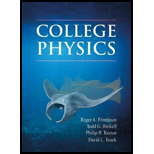
Concept explainers
The difference between electric potential and electric field..
Answer to Problem 1QAP
The electric potential is defined as the electric potential energy per unit charge while the electric field is defined as the electric force per unit charge.
Explanation of Solution
Electric potential and electric field are the two different terms use in electrical. The electric potential is defined as the electric potential energy per unit charge. In other words, electric potential is the required work to move a charge from infinite to a point in an electric field.
The expression for the electric potential is given as,
However, the electric field is defined as the electric force per unit charge. The direction of electric field is always taken in the direction of force exerted on the positive test charge.
The expression for the electric field is given as,
Conclusion:
Thus, electric potential is defined as the electric potential energy per unit charge while the electric field is defined as the electric force per unit charge.
Want to see more full solutions like this?
Chapter 17 Solutions
COLLEGE PHYSICS
- Pls help ASAParrow_forward12. A motorboat traveling 6 m/s, West encounters a water current travelling 3.5 m/s, South. a) Draw a vector diagram showing the resultant velocity, then determine the resultant velocity of the motorboat. b) If the width of the river is 112 m wide, then how much time does it take for the boat to travel shore to shore? c) What distance downstream does the boat reach the opposite shore?arrow_forwardLake Erie contains roughly 4.00⋅10114.00⋅1011 m3 of water. Assume the density of this water is 1000. kg/m3 and the specific heat of water is 4186 J/kg˚C. It takes 2.31x10^19 J of energy to raise the temperature of that volume of water from 12.0 °C to 25.8 ˚C. An electric power plant can produce about 1110 MW. How many years would it take to supply this amount of energy by using the 1110 MW from an electric power plant?arrow_forward
- Pls help ASAParrow_forwardPls help ASAParrow_forwardm m $2° 15. A truck is stopped at a red light. Once the light turns green, the truck accelerates forward at 1.75- that same instant, a car moving with a constant speed of 50 — passes the truck. a) How many seconds will it take for the truck to catch up to the car? S b) How many metres will the truck travel before it catches up to the car? Atarrow_forward
- Pls help ASAParrow_forwardI need help adding more information to my study guide. This is subject is physics My topic : Emission Spectrum Target Material I need information on this topic but make it as study guide form and make 5 questions and include the answers.arrow_forwardAn electron and a proton are each moving at 755 km/s in perpendicular paths as shown in (Figure 1). Find the magnitude of the total magnetic force that the electron exerts on the proton. Find the magnitude of the total electrical force that the electron exerts on the proton.arrow_forward
 Glencoe Physics: Principles and Problems, Student...PhysicsISBN:9780078807213Author:Paul W. ZitzewitzPublisher:Glencoe/McGraw-Hill
Glencoe Physics: Principles and Problems, Student...PhysicsISBN:9780078807213Author:Paul W. ZitzewitzPublisher:Glencoe/McGraw-Hill Physics for Scientists and Engineers, Technology ...PhysicsISBN:9781305116399Author:Raymond A. Serway, John W. JewettPublisher:Cengage Learning
Physics for Scientists and Engineers, Technology ...PhysicsISBN:9781305116399Author:Raymond A. Serway, John W. JewettPublisher:Cengage Learning
 Principles of Physics: A Calculus-Based TextPhysicsISBN:9781133104261Author:Raymond A. Serway, John W. JewettPublisher:Cengage Learning
Principles of Physics: A Calculus-Based TextPhysicsISBN:9781133104261Author:Raymond A. Serway, John W. JewettPublisher:Cengage Learning College PhysicsPhysicsISBN:9781305952300Author:Raymond A. Serway, Chris VuillePublisher:Cengage Learning
College PhysicsPhysicsISBN:9781305952300Author:Raymond A. Serway, Chris VuillePublisher:Cengage Learning Physics for Scientists and Engineers: Foundations...PhysicsISBN:9781133939146Author:Katz, Debora M.Publisher:Cengage Learning
Physics for Scientists and Engineers: Foundations...PhysicsISBN:9781133939146Author:Katz, Debora M.Publisher:Cengage Learning





